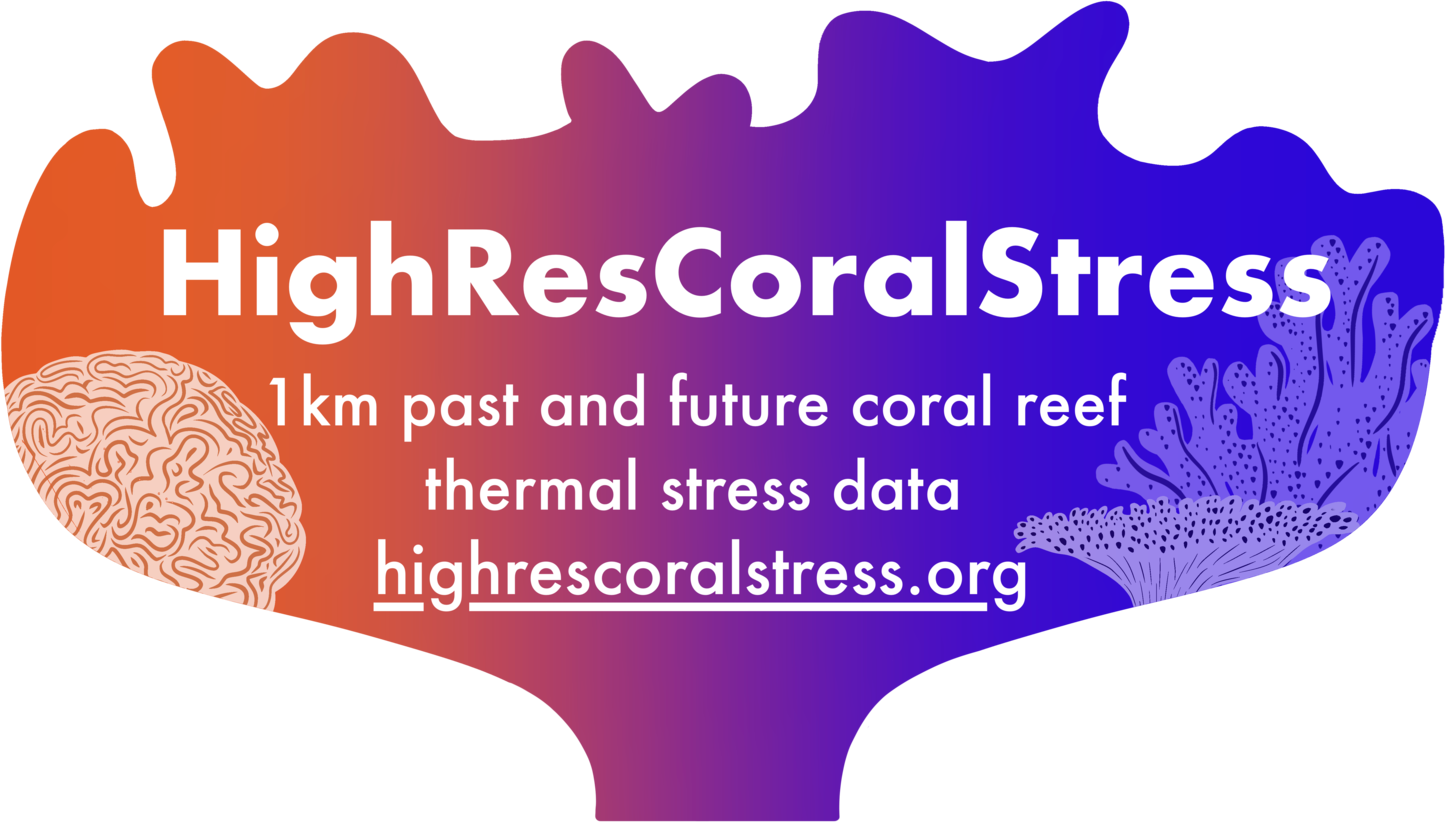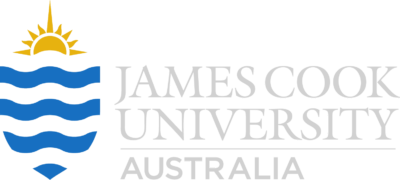
HighResCoralStress is a statistically downscaled thermal stress dataset at 0.01° / 1 km spatial resolution for 420,334 global coral reef pixels for historical (1985-2019) and future (2020-2100) time periods. The methodology for generating the HighResCoralStress dataset is detailed in the following PLOS Climate paper.
We provide eight thermal stress metrics which can be visualised and downloaded on the Data page. Thermal stress datasets can be visualised by selecting layers on the left-hand side of the map (e.g. metric, time period, emissions scenario).
The daily downscaled SST data are available from CEDA:
Dixon, A.M., Forster, P.M., Heron, S.F., Stoner, A.M.K, Beger, M. (2023). HighResCoralStress: Observed and statistically downscaled CMIP6 projections of daily sea surface temperature (SST) at 0.01°/1 km spatial resolution for the global coral reef area from 1985 to 2100. doi: 10.5285/295ee0ee59ee43439de38f83bb818b4f
Users of the HighResCoralStress data are required to cite:
Dixon, A.M, Forster, P.M., Heron, S.F., Stoner, A.M.K., Beger, M. (2021). Future loss of local-scale thermal refugia in coral reef ecosystems. PLOS Climate, 1(2), e0000004, doi: 10.1371/journal.pclm.0000004
If you would like to keep informed of updates to the HighResCoralStress dataset, please join our mailing list.
Thermal stress metrics
Thermal stress metrics available to download on the Data page:
Description
The long-term maximum monthly mean is calculated following the method by NOAA Coral Reef Watch. The monthly mean climatologies are calculated for each month from 1985-2012 and are then re-centred on the period 1985-1990 + 1993. The maximum of the 12 monthly climatologies is selected as the maximum monthly mean.Time period
Observed: 1985-2019Notes
The model MMMs are not available to view on the map but are available to download.Description
The sum of the number of days with DHW > 4°C-weeks. DHW is the sum of SST anomalies 1°C higher than the long-term maximum monthly mean (MMM) over a 12-week period calculated following the method by NOAA Coral Reef Watch.Time period
Observed: 1985-2019, Projected: 2021-2040, 2041-2060, 2061-2080, 2081-2100Emissions scenario
SSP1 2.6, SSP2 4.5, SSP3 7.0, SSP5 8.5Description
The sum of the number of days with DHW > 8°C-weeks. DHW is the sum of SST anomalies 1°C higher than the long-term maximum monthly mean (MMM) over a 12-week period calculated following the method by NOAA Coral Reef Watch.Time period
Observed: 1985-2019, Projected: 2021-2040, 2041-2060, 2061-2080, 2081-2100Emissions scenario
SSP1 2.6, SSP2 4.5, SSP3 7.0, SSP5 8.5Description
The number of events with DHW > 4°C-week divided by the total number of years. DHW is the sum of SST anomalies 1°C higher than the long-term maximum monthly mean (MMM) over a 12-week period calculated following the method by NOAA Coral Reef Watch.Reference
Donner et al. (2009), Frieler et al. (2013), Schleussner et al. (2016), Dixon et al. (2022)Time period
Observed: 1985-2019, Projected: 2021-2040, 2041-2060, 2061-2080, 2081-2100Emissions scenario
SSP1 2.6, SSP2 4.5, SSP3 7.0, SSP5 8.5Description
The number of events with DHW > 8°C-week divided by the total number of years. DHW is the sum of SST anomalies 1°C higher than the long-term maximum monthly mean (MMM) over a 12-week period calculated following the method by NOAA Coral Reef Watch.Reference
Donner et al. (2009), Frieler et al. (2013), Schleussner et al. (2016), Dixon et al. (2022)Time period
Observed: 1985-2019, Projected: 2021-2040, 2041-2060, 2061-2080, 2081-2100Emissions scenario
SSP1 2.6, SSP2 4.5, SSP3 7.0, SSP5 8.5Description
Root mean square (RMS) of spectral energy in the seasonal band (0.5-1 year) calculated by transforming monthly SST into frequency bands using Fourier transform.Reference
Langlais et al. (2017), Dixon et al. (2022)Time period
Observed: 1985-2019Description
Root mean square (RMS) of spectral energy in the for the inter-annual band (3-8 year) calculated by transforming monthly SST into frequency bands using Fourier transform.Reference
Langlais et al. (2017), Dixon et al. (2022)Time period
Observed: 1985-2019Description
Slope for feasible generalised least squares model fit to annual mean SST with autocorrelation structure of 1. The p value (p_value) is also reported.Reference
Chollet et al. (2022)Time period
Observed: 1985-2019Acknowledgements
The authors thank all the data providers whose datasets have fed into HighResCoralStress including the following observed datasets:
Source: Group for High Resolution Sea Surface Temperature at NASA Jet Propulsion Laboratory
Reference: Chin et al. (2017)
DOI: 10.5067/GHGMR-4FJ04
Source: ESA SST CCI
Reference: Merchant et al. (2019)
DOI: 10.5285/916b93aaf1474ce793171a33ca4c5026, 10.5285/373638ed9c434e78b521cbe01ace5ef7, 10.5285/2282b4aeb9f24bc3a1e0961e4d545427, 10.5285/42f7230ab55641cdac1bba84eabd446a, 10.5285/5db2099606b94e63879d841c87e654ae, 10.5285/7db4459605da4665b6ab9a7102fb4875, 10.5285/62c0f97b1eac4e0197a674870afe1ee6
Source: NOAA Coral Reef Watch
Reference: NOAA Coral Reef Watch (2018)
Source: UNEP-WCMC, WorldFish Centre, WRI, TNC
Reference: UNEP-WCMC, WorldFish Centre, WRI, TNC, (2010)
DOI: 10.34892/t2wk-5t34
The authors acknowledge the World Climate Research Programme, which, through its Working Group on Coupled Modelling, coordinated and promoted CMIP6. The authors thank the climate modelling groups for producing and making available their model output, the Earth System Grid Federation (ESGF) for archiving the data and providing access, and the multiple funding agencies who support CMIP6 and ESGF.
Historical, SSP1-2.6, SSP2-4.5, SSP3-7.0 and SSP5-8.5 r1i1p1f1 simulations were used for all models except NESM3 (no SSP3-7.0 available at time of download) and GFDL-CM4 (no SSP1-2.6 and SSP3-7.0 available at time of download).
Insitute: CSIRO
Reference: Bi et al. (2020)
Insitute: CSIRO
Reference: Ziehn et al. (2020)
Insitute: BCC
Reference: Wu et al. (2019)
Insitute: CCCma
Reference: Swart et al. (2019)
Insitute: NCAR
Reference: Danabasoglu et al (2020)
Insitute: CMCC
Reference: Cherchi et al. (2019)
Insitute: EC-Earth-Consortium
Reference: Döscher et al. (2021)
Insitute: EC-Earth-Consortium
Reference: Wyser et al. (2020)
Insitute: NOAA-GFDL
Reference: Held et al. (2019)
Insitute: IPSL
Reference: Boucher et al. (2020)
Insitute: MRI
Reference: Yukimoto et al. (2019)
Insitute: NUIST
Reference: Cao et al. (2018)
Insitute: NCC
Reference: Seland et al. (2020)
Insitute: NCC
Reference: Seland et al. (2020)
Contact
If you have any enquiries, please contact Maria Beger at M.Beger@leeds.ac.uk.





